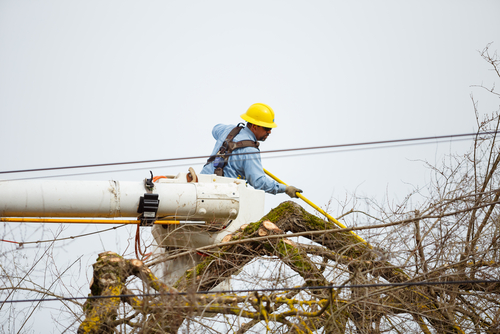Worker shortage could hamper California vegetation management goals

Lumberjacks may be the latest skilled trade in short supply for the power companies serving wide areas of California that are prone to wildfires.
Vegetation management (VM) around power lines is a long-standing practice for utilities as a means of preventing downed or arcing wires, which not only inconvenience customers but can also ignite destructive fires.
The California Public Utilities Commission (CPUC) this week approved a wildfire mitigation strategy proposed by the state’s major utilities that includes the idea of shutting off electricity as a precautionary measure on days when winds and other weather conditions make it more likely that falling trees and branches could cause arcing or send a live electrical wire into dangerously dry brush. The mitigation plan, approved May 30, raises the likelihood of communities located in the mountains and foothills being without electricity for as long as a few days at times when the state’s infamous Santa Ana “devil winds” keep conditions dicey from the deserts to the coast.
“De-energizing power lines may be necessary as a last resort to avert devastating utility-caused wildfires,” said CPUC Commissioner Clifford Rechtschaffen, “This decision provides important guidance for how utilities must notify vulnerable populations, first responders, and the public about such events, and other protocols they must follow.”
An alternative to shutting off power to thousands of customers would be to thoroughly clear brush and problematic trees away from power lines ahead of fire season, but the sheer size of the forests and brushy areas involved requires fielding an army of workers willing and able to do the job. Pacific Gas & Electric (G&E) estimates it has around 100 million trees in its service area that have the potential to grow into or fall on to its overhead power lines.
Utility officials warned that while they have already accelerated VM activities, ramping up further will not be as easy as it sounds due to the shortage of qualified workers and contractors available.
Last year, PG&E morphed its VM program into an Enhanced Vegetation Management (EVM) program to not only remove more trees and vegetation, but also increase the size of the buffer zones around power poles and transmission towers. The ambitious EVM, however, is a labor-intensive effort that requires people who are not only skilled with a saw and chipper, but are also trained to work safely in close proximity to power lines.
“The most significant challenge to the EVM program schedule is the limited availability of qualified work force, which limits the maximum pace of the work,” PG&E said in an Oct. 25, 2018 filing with the CPUC.
The document cautioned: “Not only is logging and tree felling one of the most hazardous industries in the nation, but the Northern California forests pose a very different challenge than most parts of the country. Safely removing a 200-foot-tall tree in proximity of a high voltage distribution line cannot just be performed by anyone with a chain saw.”
PG&E said it went so far in 2018 as to request reinforcements from other utilities in California – and the rest of the nation – under a mutual-assistance agreement. Unfortunately, resources were already stretched thin due to other weather-related emergencies and because mutual-assistance workers were only able to stay in PG&E’s territory for limited periods.
The company said that seeking bids from VM contractors nationwide did not find a lot enthusiasm. Out of 46 companies that were not already working for PG&E, only nine left the door open. “The remaining nine vendors expressed, in aggregate, an ability to mobilize possibly a few hundred qualified personnel to California and generally expressed an interest in only emergency/short-term work, not a willingness to commit long-term to developing a workforce in California,” PG&E told the CPUC.
As a result, PG&E estimated it could put together about 3,000 tree workers who could be deployed from 2019 through approximately 2026. This year, PG&E estimates it will have cleared massive piles of brush and 375,000 trees from around 2,450 miles of transmission lines; that compares to 160,000 trees felled along 760 miles in 2018. That pace might flatten out in a few years as PG&E gets caught up with the backlog.
